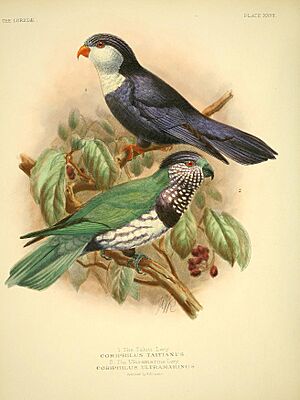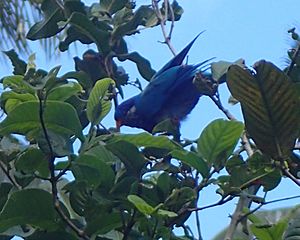Ultramarine lorikeet facts for kids
Quick facts for kids Ultramarine lorikeet |
|
|---|---|
 |
|
| Vini ultramarina (below), with Vini peruviana | |
| Conservation status | |
| Scientific classification | |
| Genus: |
Vini
|
| Species: |
ultramarina
|
The ultramarine lorikeet (Vini ultramarina) is a small, colorful parrot. It belongs to the Psittaculidae family. This special bird lives only on the Marquesas Islands. These islands are in the Pacific Ocean.
The lorikeet's natural homes are warm, wet forests. It also lives in mountain forests and on plantations. Sadly, this bird is critically endangered. This means it is at a very high risk of disappearing forever. The biggest dangers are black rats and deforestation.
Contents
Where Does This Lorikeet Live?
In the 1970s, the ultramarine lorikeet lived on several islands. These included Fatu Hiva, Ua Pou, Nuku Hiva, and Ua Huka. All these islands are part of the Marquesas Islands.
But things changed quickly. A lot of forests were cut down. Also, black rats and cats were brought to the islands. These animals hunted the lorikeets. By 2008, the bird had disappeared from Fatu Hiva, Ua Pou, and Nuku Hiva.
Today, this rare bird only lives on Ua Huka. Experts believe there are about 1,000 to 2,499 lorikeets left there.
What Does the Lorikeet Eat?
The Vini ultramarina eats many different things. It loves nectar and pollen from flowers. It also eats the flowers themselves. It seems to really like flowers from coconut palm trees. It also enjoys flowers from the Hibiscus tilliaceus plant.
Besides flowers, the bird's diet includes various fruits. It also eats small insects.
Where Does It Nest?
Ultramarine lorikeets make their nests inside holes in trees. They often choose trees like Artocarpus altilis, Pometia pinnata, Pandanus tectorius, and Hibiscus tilliaceus. We still have a lot to learn about this special bird.
Why Is It Endangered?
The ultramarine lorikeet faces big threats. One of the biggest is the black rat. These rats were brought to Nuku Hiva in 1915. They hunt the lorikeets and their eggs. This has caused the bird's numbers to drop a lot.
Many islands have also been badly damaged. Too many animals grazing (eating plants) and fires have hurt the land. Most of the original dry forests are now just grasslands. Even the forests in the mountains have been harmed.
Deforestation is another major problem. Forests are cut down to make room for farms. Trees are also cut for logging (wood). And land is cleared for tourism (places for visitors). All these activities have greatly reduced the lorikeet's population.



